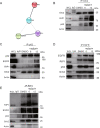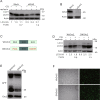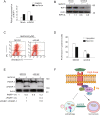Grb2 interacts with necrosome components and is involved in rasfonin-induced necroptosis
- PMID: 35831301
- PMCID: PMC9279413
- DOI: 10.1038/s41420-022-01106-1
Grb2 interacts with necrosome components and is involved in rasfonin-induced necroptosis
Abstract
The underlying mechanism by which growth factor receptor-bound protein 2 (Grb2) regulates necroptosis remains unexplored. In the present study, we found that rasfonin, a fungal natural product and an activator of necroptosis, enhanced Grb2 binding to receptor-interacting serine/threonine kinase 1 (RIP1), which plays a critical role in regulating programmed necrosis. Moreover, we observed that SQSTM/p62 (p62), a protein that can form necrosomes with RIP1, increased its interaction with Grb2 upon rasfonin challenge. Although it has been used as an activator of autophagy in our previous study, here we found that a high dose of rasfonin was able to inhibit autophagic process. Inhibition of RIP1 either chemically or genetically reversed the inhibition of rasfonin on autophagy, whereas knockdown of Grb2 markedly reduced rasfonin-induced necrosis. Additionally, we found that the compound failed to upregulate the expression of RIP1 in Grb2-deprived cells. In summary, our data revealed that Grb2 actively participated in rasfonin-induced necroptosis by interacting with the components of necrosome and mediating their expression.
© 2022. The Author(s).
Conflict of interest statement
The authors declare no competing interests.
Figures







Similar articles
-
Fungal secondary metabolites rasfonin induces autophagy, apoptosis and necroptosis in renal cancer cell line.Mycology. 2016 May 9;7(2):81-87. doi: 10.1080/21501203.2016.1181114. eCollection 2016. Mycology. 2016. PMID: 30123619 Free PMC article.
-
PI3K mediates tumor necrosis factor induced-necroptosis through initiating RIP1-RIP3-MLKL signaling pathway activation.Cytokine. 2020 May;129:155046. doi: 10.1016/j.cyto.2020.155046. Epub 2020 Feb 28. Cytokine. 2020. PMID: 32114297
-
CYLD deubiquitinates RIP1 in the TNFα-induced necrosome to facilitate kinase activation and programmed necrosis.PLoS One. 2013 Oct 2;8(10):e76841. doi: 10.1371/journal.pone.0076841. eCollection 2013. PLoS One. 2013. PMID: 24098568 Free PMC article.
-
The role of necroptosis in pulmonary diseases.Respir Investig. 2016 Nov;54(6):407-412. doi: 10.1016/j.resinv.2016.03.008. Epub 2016 Jun 7. Respir Investig. 2016. PMID: 27886851 Review.
-
The Necrosome in Acute Kidney Injury.Semin Nephrol. 2016 May;36(3):199-207. doi: 10.1016/j.semnephrol.2016.03.007. Semin Nephrol. 2016. PMID: 27339385 Review.
Cited by
-
Identification of Grb2 protein as a potential mediator of macrophage activation in acute pancreatitis based on bioinformatics and experimental verification.Front Immunol. 2025 May 26;16:1575880. doi: 10.3389/fimmu.2025.1575880. eCollection 2025. Front Immunol. 2025. PMID: 40491924 Free PMC article.
-
Propranolol and Capecitabine Synergy on Inducing Ferroptosis in Human Colorectal Cancer Cells: Potential Implications in Cancer Therapy.Cancers (Basel). 2025 Apr 27;17(9):1470. doi: 10.3390/cancers17091470. Cancers (Basel). 2025. PMID: 40361395 Free PMC article.
-
Modifications in cellular viability, DNA damage and stress responses inflicted in cancer cells by copper-64 ions.Front Med (Lausanne). 2023 Jun 21;10:1197846. doi: 10.3389/fmed.2023.1197846. eCollection 2023. Front Med (Lausanne). 2023. PMID: 37415761 Free PMC article.
References
-
- Ijaz M, Wang FS, Shahbaz M, Jiang WJ, Fathy AH, Nesa EU. The role of Grb2 in cancer and peptides as Grb2 antagonists. Protein Pept Lett. 2017;24:1084–95. - PubMed
Grants and funding
LinkOut - more resources
Full Text Sources
Research Materials
Miscellaneous

